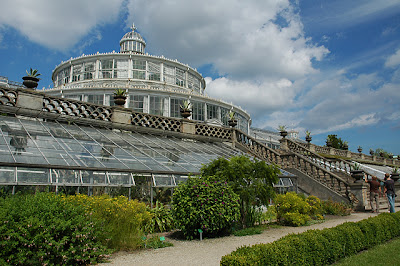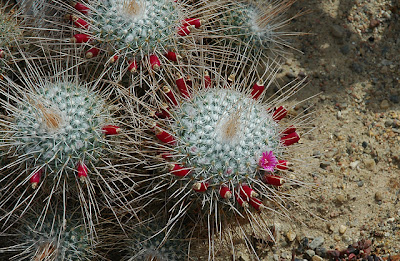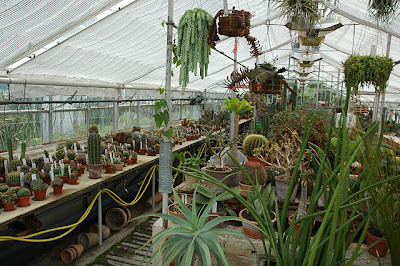I’ve previously made an attempt at a stop-motion video showing the thigmotropic behavior of Lophophora stamens. It so happened that the Lophophora williamsii var. jourdaniana plant flowered again during my summer vacation, leaving me plenty of time to experiment with time-lapse videos.
The first video shows the Lophophora williamsii var. jourdaniana flower unfold (I’m not exactly an early bird so I missed the first part of the unfolding ;-)
The above video covers a time span of approximately 90 minutes, i.e. playback is sped up by a factor of 150. This is my first attempt at a time-lapse “flower movie”, as can be seen by the quality of the film. The first 11 seconds were shot while the camera was in auto-focus mode, resulting in a “wobbly” feel. I then disabled auto-focus (and lost a couple of frames in the process, which can be seen as a “jump” 11 seconds into the video) and later had to re-focus (28 seconds into the video), so it's not perfect, but not bad either. The frames were shot with the sun as the only source of light.
Next, I wanted to make a better (i.e. more frames per second) version of the thigmotropic stamens video but ended up with a version looking a lot like the original one.
The playback of the above video is sped up by a factor of 12. Unfortunately I stopped taking pictures just as the stamens started to revert to their original position. In an attempt to achieve more frames per second I played around with my cameras continuous shooting mode. Suddenly the flower was visited by an industrious bee beautifully illustrating the purpose of the touch sensitive stamens ;-)
I guess the last 2 clips would be more illustrative if they had been filmed with a regular video camera instead of an SLR, but they’ll have to do for now. Unfortunately my camera ran out of power effectively putting an end to the filming of this particular flower.
Finally I have to mention the Hydrocactus – cactus video page as the main inspiration for these experiments and the best source of cactus videos I’m aware of.
Friday, August 17, 2007
Time-lapse videos of a flowering Lophophora jourdaniana
Thursday, August 16, 2007
Copenhagen Botanical Garden & Museum
I spent part of my summer vacation in Copenhagen and naturally had to visit the Botanical Garden and Museum. The garden is located in the center of the city and has many visitors. Unlike most other gardens and parks in Copenhagen, the purpose of the botanical garden is research. Therefore, “it is not allowed to run, to ride a bicycle, climb the trees, stay on or walk on the lawns, pick the flowers or picnic.” These rules are a gross limitation on Danes who generally light bonfires and run around naked on lawns ;-)

The Conservatory
The botanical garden was established August 2, 1600, and has moved and changed during the centuries. The fourth and present incarnation of the garden was opened to the public on October 9, 1874, 274 years after the founding of the first botanical garden (the vanes on the conservatory roof date the construction to 1873).
The cactus and succulent plants have their own dedicated greenhouse in these wonderful settings. Facing the stairs leading to the main conservatory building (the palm house), the cactus and succulent house is located to the left of the stairs, one level lower than the palm house.

The cactus and succulent house
Inside the cactus house you’ll find an abundance of plants – both small globular types and huge columnar plants. It seems like theft of the smaller plants is a problem as they are protected by glass plates and the whole house is monitored by video.

Inside the cactus and succulent house
The plants all look vigorous and well tended for, as for example this group of flowering Astrophytum ornatum plants (for comparison you can check the A. ornatum growing in the Myriad Botanical Gardens, Oklahoma City).

Flowering Astrophytum ornatum

Astrophytum ornatum flower
A large, fat Astrophytum asterias was hiding in the shadows of the larger plants.

Astrophytum asterias
And a Mammillaria geminispina was displaying its last flowers along with a multitude of dark red fruits.

Mammillaria geminispina
Unfortunately I couldn’t find any Lophophora, Ariocarpus, or Strombocactus in the publicly accessible houses; but the garden also has houses that are not open to the public and reserved for experiments and plant propagation. Maybe it’s just wishful thinking, but I’m almost positive I glimpsed a collection of ariocarpi and a few lophs inside one of these houses.

Propagation house – closed to the public
If you happen to be in Copenhagen a visit to the Botanical Garden and Museum is highly recommended. It’s a tranquil oasis situated in the center of a bustling city, and the historical conservatory buildings are beautiful in their own right (the garden was declared a preserved site on January 31, 1977). You might not find a lot of the rarer species in the houses open to the public, but the plants on display are abundant, well grown, and clearly marked.
All Time Most Popular Posts
-
Lophophora williamsii (peyote) populations have diminished in large areas of South Texas where peyoteros harvest the cactus for ceremonial ...
-
On various occasions I've been asked what growing media I'm using for my cactus plants. I don't have a set soil mix recipe as su...
-
Below is a list of retailers/nurseries selling cactus seed and plants. I've only listed vendors I've done business with. If you ar...
-
Most cacti are easily grown from seed - and with a little patience and care they can be grown into beautiful plants. Lophophora williamsi...
-
In last month’s post on the troubled Texan peyoteros I referred to Anderson’s article on the peyote situation in Texas. Given the importanc...
-
Yet another slightly off topic and probably not entirely politically correct post, but I couldn’t help noticing the similarity of my monstr...
-
Flowering stand of San Pedro cacti (Trichocereus pachanoi) To me the main draw of the San Pedro cactus ( Trichocereus pachanoi (syn. Ech...
-
In the June 2008 issue of the Cactus & Co magazine Jaroslav Šnicer, Jaroslav Bohata, and Vojtěch Myšák described a new Lophophora spec...
-
There seems to be an increased focus on the alarming Texas peyote situation. A couple of weeks ago the Houston Press published a mournful, i...
-
I spent two weeks working in Delhi, India during January. I had one weekend off and had planned to spend it in Delhi at my own leisure, but ...


















